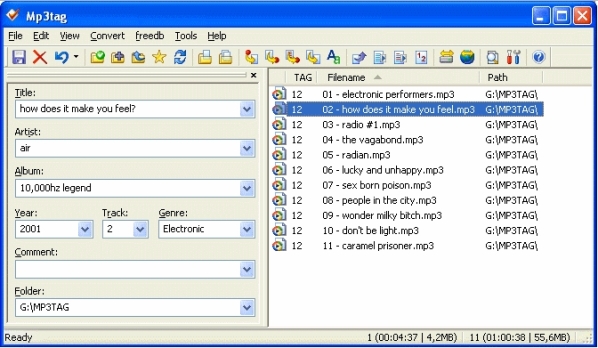

- #MP3TAG CONVERT ID3V2.4 TO ID3V2.3 HOW TO#
- #MP3TAG CONVERT ID3V2.4 TO ID3V2.3 FULL#
- #MP3TAG CONVERT ID3V2.4 TO ID3V2.3 FREE#
- #MP3TAG CONVERT ID3V2.4 TO ID3V2.3 WINDOWS#
How to upgrade from ID3v1 to ID3v2, then? Well, you're probably not surprised to hear that bliss includes a rule to upgrade all of the tags for an album. Furthermore, in my experience, older versions of phones based on Symbian fail to read ID3v2.4 tags.
#MP3TAG CONVERT ID3V2.4 TO ID3V2.3 WINDOWS#
Versions of Windows Media Player up to and including version 12, and also Windows 7, do not recognise ID3v2.4 tags. However, I would caution the adoption of ID3v2.4, the latest version of the standard. The good news is that now the overwhelming majority of music players support ID3v2. The obvious caveat, a common one in digital music tagging, is that whatever tag format you use it should be supported by your music player. So it's best to move onto ID3v2 then? Well, yes, generally. Using the likes of ReplayGain for volume normalisation is impossible with ID3v1. But also it means that the format is not keeping up with technology. One example of the effect of this is the issue with a finite genre list, discussed above. If you're streaming the files, however, you have to do some other magic to communicate the tag contents. If the files are on your hard disc, that's fine. ID3v2 still supports the genre list introduced in ID3v1.
#MP3TAG CONVERT ID3V2.4 TO ID3V2.3 FREE#
The enhanced ID3v1 tag, introduced later, allowed free text genres. The genre tag was a number that matched the predefined ID3 genre list. ID3v1 introduced a numeric format for genre tagging. Actually, some might consider this a positive thing given the crazy genres that can otherwise permeate your collection! Still, as music is fluid and new genres appear all the time, this is a restriction that could grow more serious with time. Personally, I think the advantages of embedded artwork outweigh the disadvantages, so it's important to me.

This may or may not be relevant, according to whether you embed album art or not. You cannot embed album art inside ID3v1 tags. It's even worse in the original version of ID3, which allowed only 30 characters. In my own collection I have a performance of Philip Glass's Violin Concerto weighing in at 93 characters. If you adopt the standard classical titling format of conductor, orchestra, soloist, for example, this space can soon be used up and may cause truncation of data. That sounds a lot, but for classical music in particular it's not as capacious as it may appear. At best, with 'enhanced' ID3v1 tags you can store up to 90 characters in the album name, artist name or track title fields. There are a number of disadvantages to ID3v1 tags, which is why ID3v2 was developed to take its place.

The upshot is that ID3v1 tags still exist today and there's a decent chance you may have some in your own music collection, probably in a dusty, out of the way corner that you only rarely revisit. Furthermore, due to a lag in music players not supporting the new ID3v2 format, it continued to be used for a good while. In the couple of years it was the premier format for MP3 metadata ID3v1 was extremely popular.
#MP3TAG CONVERT ID3V2.4 TO ID3V2.3 FULL#
The full name of the first public release of ID3v2 was ID3v2.2 and since its introduction, it itself has been improved a couple of times in ID3v2.3 and ID3v2.4. Although both format share a similar name, ID3v2 was a complete rewrite of ID3v1 and the two bear little resemblance. Limitations were discovered in the way ID3v1 stored its data however, and ID3v2 was released in 1998. This gained widespread acceptance and was used by the emerging ripping communities to store metadata for their MP3s. The original version was released back in 1996 and is what we now know as ID3v1. In the case of MP3s, which remain the most popular format, the ID3 tagging format is used. There are different types of tags, but the one you use is normally determined by the digital music format you chose. Metadata, such as album name, artist name, year of release and more, are stored inside 'tags' in digital music files.


 0 kommentar(er)
0 kommentar(er)
